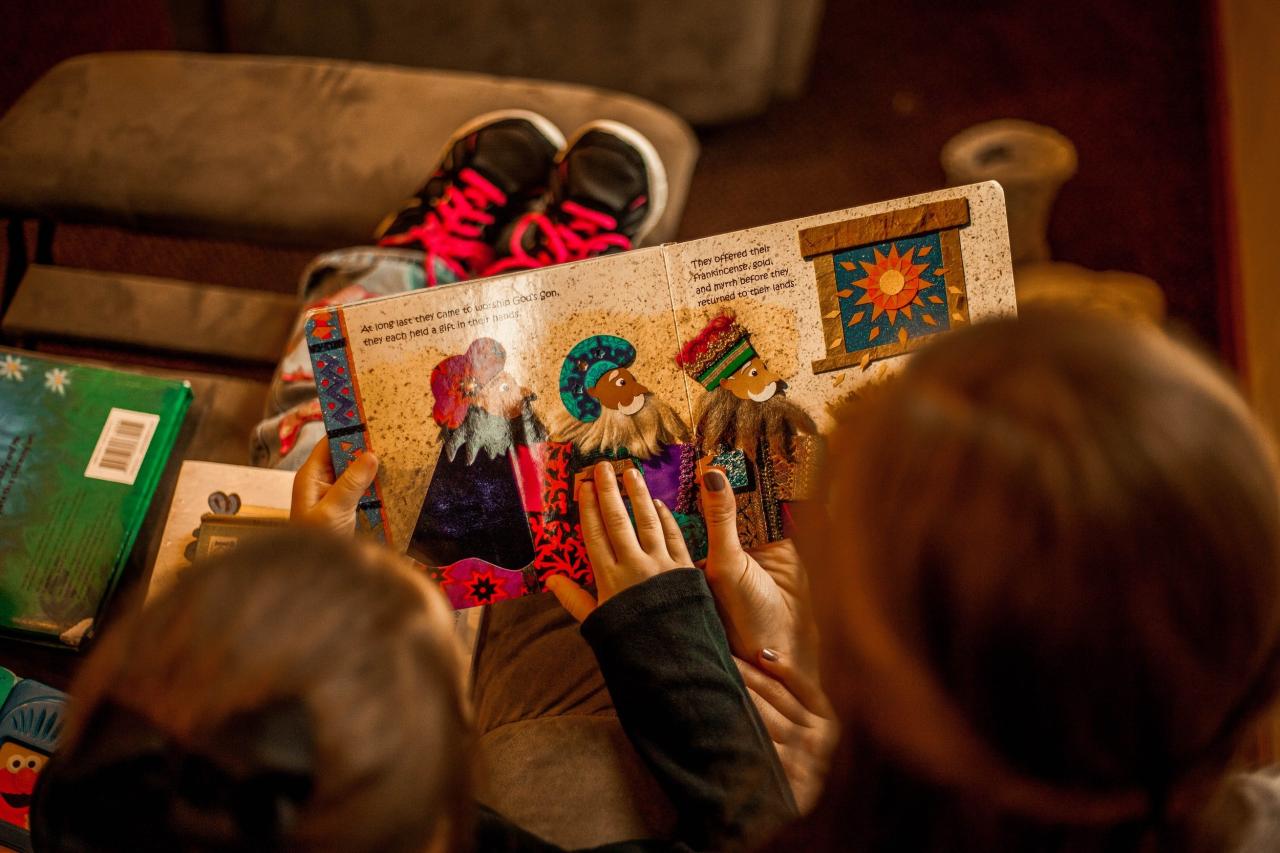
15 Ways to Create a Lifelong Love of Reading with Your Kiddos
15 ways to create a lifelong love of reading with your kiddos – Imagine a world where your child eagerly anticipates bedtime stories, devours books during car rides, and finds joy in exploring the written word. This isn’t a dream; it’s a reality you can cultivate with a little effort and a whole lot of love for reading.
15 Ways to Create a Lifelong Love of Reading with Your Kiddos takes center stage, guiding you through a journey of nurturing a passion for books that will last a lifetime.
From the earliest stages of development, you can lay the foundation for a deep and enduring love of reading. By making books a part of your child’s everyday life, you’re not just teaching them to read; you’re igniting a spark of curiosity that will fuel their intellectual and emotional growth for years to come.
Engage Their Imagination: 15 Ways To Create A Lifelong Love Of Reading With Your Kiddos

Books can be more than just words on a page; they can be portals to endless possibilities. By encouraging your child to use books as a springboard for imaginative play, you can cultivate a love of reading that goes beyond simply decoding words.
Role-Playing and Imaginative Worlds
Role-playing is a fantastic way to bring stories to life. Encourage your child to act out scenes from their favorite books, adopting different characters’ voices and personalities. This not only enhances their understanding of the story but also allows them to explore different perspectives and emotions.
For instance, after reading “The Very Hungry Caterpillar,” you can create a caterpillar puppet with your child and have them act out the story. This playful activity helps them connect with the characters and develop their empathy.
Drawing and Visual Storytelling
Drawing is a powerful tool for visual storytelling. After reading a book, ask your child to draw their favorite scene or character. This encourages them to think about the details of the story and translate them into visual form. You can also use drawing as a way to spark their imagination by asking them to draw a scene from their own story.
Connecting Reading to Real-World Experiences
Reading doesn’t have to be confined to the pages of a book. Encourage your child to connect what they read to real-world experiences. If you’re reading a book about animals, take a trip to the zoo or a local park.
If you’re reading a book about cooking, involve them in the process of preparing a meal. These connections help them understand the relevance of reading and make it more engaging.
Visit Libraries and Bookstores
Exposing your children to a diverse array of books is crucial for fostering a love of reading. Libraries and bookstores provide an ideal setting for this exposure, offering a wealth of options that cater to various interests and reading levels.
Planning Library and Bookstore Visits, 15 ways to create a lifelong love of reading with your kiddos
Planning library and bookstore visits effectively ensures that these outings are both enjoyable and educational for your children. To make the most of these experiences, consider the following tips:
- Choose a Library or Bookstore Based on Your Child’s Interests: When selecting a library or bookstore, consider your child’s current interests and reading level. This will help narrow down the options and make the experience more engaging for them. For instance, if your child is fascinated by dinosaurs, a library with a dedicated children’s section featuring dinosaur-themed books would be an excellent choice.
- Plan Ahead for a Smooth Visit: Prepare for your library or bookstore visit by checking the library’s hours, book availability, and any special events. For bookstores, browse their website or call ahead to inquire about specific titles or author events. This pre-planning ensures a smoother and more enjoyable experience.
- Set Realistic Expectations: Remember that children have varying attention spans, so set realistic expectations for how long your child will be interested in browsing or reading. It’s perfectly fine to leave if your child starts getting restless or overwhelmed.
Making Library and Bookstore Visits Enjoyable and Educational
Transforming library and bookstore visits into enriching experiences requires engaging your child’s imagination and making the process fun and interactive.
- Make It a Game: Turn your library or bookstore visit into a game by asking your child to find specific books based on their interests or by setting a goal for how many books they can browse through.
- Read Together: Dedicate some time to reading aloud from books you find together. This not only fosters a love of reading but also creates a shared experience and strengthens your bond.
- Encourage Exploration: Allow your child to explore the library or bookstore independently, encouraging them to discover books that pique their interest. This promotes their sense of autonomy and allows them to develop their own reading preferences.
Connect Reading to Interests
Making reading a joyful experience for your child involves connecting it to their passions. When children see how books relate to their interests, reading becomes a way to explore, learn, and delve deeper into their favorite things.
I’m all about making reading fun for my kids, and I’ve found that creating a cozy reading nook with comfy pillows and a soft blanket is a great way to start. Of course, I can’t forget about the fashion element! I love pairing a comfy sweater with a pair of colored jeans and three ways to wear them for a fun, casual look.
Back to the reading nook, though, I also think it’s important to choose books that are age-appropriate and engaging, and to read aloud to them regularly. It’s amazing to see their little minds grow as they learn new words and explore different worlds!
Finding Books Aligned with Children’s Passions
The key to finding books that ignite a child’s interest is to understand their passions. This could involve their hobbies, sports they enjoy, animals they love, or any other topic that captures their imagination.
Examples of Books Related to Hobbies, Sports, Animals, and Other Interests
Here are some examples of books that can connect with children’s interests:
- Hobbies:
- For children who love art, “The Art Book for Kids: 100+ Activities to Explore, Create, and Celebrate Art” by Fiona Watt and Philippa Rice offers a fun and engaging way to explore different art forms.
- For young music enthusiasts, “The Music Book for Kids: 100+ Activities to Explore, Create, and Celebrate Music” by Fiona Watt and Philippa Rice introduces them to various musical instruments and genres.
- Sports:
- “The Story of Basketball” by Peter Golenbock provides a comprehensive history of basketball, perfect for budding basketball players.
- “The Magic Tree House: Soccer on the Seine” by Mary Pope Osborne introduces children to the sport of soccer through a time-traveling adventure.
- Animals:
- “The Very Hungry Caterpillar” by Eric Carle is a classic story about a caterpillar’s journey, perfect for children fascinated by insects.
- “National Geographic Kids Ultimate Book of Animals” by National Geographic provides a wealth of information about various animal species, from the smallest insects to the largest mammals.
- Other Interests:
- For children interested in space exploration, “The Magic School Bus Lost in Space” by Joanna Cole and Bruce Degen takes readers on a thrilling journey through the solar system.
- For young history buffs, “The American Girl: Felicity Merriman” series by Pleasant Company offers a glimpse into colonial America through the eyes of a young girl.
Using Reading to Expand Children’s Knowledge and Interests
Reading can be a powerful tool for expanding a child’s knowledge and interests. By introducing them to books that align with their passions, you can encourage them to learn more about the world around them.
Make Reading a Social Activity
Reading doesn’t have to be a solitary activity. Sharing the joy of books with others can make it even more engaging and rewarding. By creating a social atmosphere around reading, you can foster a love for literature that lasts a lifetime.
From turning bedtime stories into interactive adventures to creating a cozy reading nook, there are endless ways to foster a love of reading in your little ones. But sometimes, even the most dedicated parent needs a break! If you’re looking for a fun and easy way to unwind, check out last minute costume ideas for the grownups for a quick and creative escape.
Then, you can return to the wonderful world of books and share your love of reading with your children, inspiring a lifelong passion for stories.
Book Clubs
Book clubs provide a structured environment for children to discuss books, share their thoughts, and learn from each other.
Reading aloud to your kids is one of the best ways to nurture their love of books. From silly voices to engaging discussions, it’s a magical journey you share together. It’s amazing how a simple act can ignite a passion for stories, like watching Chris Pratt transform from a lovable goofball in “The Lego Movie” to a fearless hero in “Guardians of the Galaxy” – he really embodies the spirit of adventure! And just like Chris Pratt can switch roles seamlessly, your kids can too, going from being a captivated listener to a confident reader themselves with the right encouragement and opportunities.
- Start a book club with friends or family.Choose age-appropriate books and discuss them together. You can even make it a themed book club, focusing on a specific genre or author.
- Join a local library or community book club.Many libraries offer book clubs for children of different ages. This is a great way to meet other kids who share a love of reading.
- Use online platforms to connect with book clubs.Websites and apps like Goodreads and BookBub offer opportunities to find virtual book clubs for kids.
Reading Aloud Together
Reading aloud together creates a shared experience that can spark conversations and deepen understanding.
- Make it a regular routine.Set aside time each day or week to read aloud together. Choose a cozy spot and make it a special time.
- Involve everyone in the process.Take turns reading aloud, or have everyone read a paragraph or two. This encourages active participation and builds confidence.
- Ask questions and engage in discussions.Encourage your child to share their thoughts and feelings about the story. This helps them to connect with the text on a deeper level.
Author Events
Attending author events provides a unique opportunity for kids to meet their favorite authors and learn about the writing process.
- Check local libraries and bookstores for author events.Many authors visit libraries and bookstores to promote their books and meet readers.
- Attend book festivals and literary events.These events often feature author readings, workshops, and book signings.
- Encourage kids to ask questions.Authors are often happy to answer questions about their writing process, characters, and inspirations.
Model Reading Behavior
Children learn by observing and imitating, and this is especially true when it comes to developing a love of reading. Modeling reading behavior is a powerful way to instill a lifelong passion for books in your children.
Demonstrate the Joy of Reading
It’s not enough to simply have books around the house. You need to show your children that you enjoy reading. Make time to read for pleasure every day, even if it’s just for a few minutes. Let your children see you engrossed in a book, and share your enthusiasm for the stories you’re reading.
When you’re reading, talk about what you’re enjoying and why.
“Children learn by observing and imitating, and this is especially true when it comes to developing a love of reading.”
Make Reading a Part of Your Daily Routine
Reading doesn’t have to be a formal activity. Incorporate reading into your daily routine in natural ways. Read aloud to your children during bedtime, mealtimes, or while driving in the car. Make reading a part of your family’s evening routine.
Discuss Books with Your Children
Talking about books helps children engage with the material on a deeper level. Ask them questions about the story, the characters, and the plot. Encourage them to share their thoughts and feelings about what they’ve read.
Create a Reading-Friendly Environment
Make your home a welcoming space for reading. Have comfortable seating, good lighting, and a variety of books available. Consider creating a designated reading nook or library corner in your home.
Celebrate Reading

Reading shouldn’t feel like a chore. Make it a fun and rewarding experience for your children by celebrating their reading milestones. Turn reading into a special occasion and watch their love for books blossom.
Recognize Reading Accomplishments
Rewarding children for their reading efforts is an excellent way to encourage them to continue reading. It shows them that their hard work is appreciated and motivates them to keep pushing forward.
- Award Certificates:Design personalized certificates to acknowledge children’s reading achievements. For example, create a “Bookworm Award” for completing a specific number of books or a “Reading Champion” certificate for consistently reading for a certain amount of time. These certificates serve as tangible reminders of their progress and can be proudly displayed in their room.
- Host Reading Parties:Turn reading into a party! Gather friends and family for a reading-themed celebration. Encourage everyone to bring their favorite book and share a short excerpt. You can even have a “Book Character Dress-Up” contest for added fun. This creates a positive association with reading and makes it a social activity.
- Create a Family Reading Challenge:Engage the whole family in a reading challenge. Set a goal for the number of books to be read within a specific time frame. Award prizes for reaching milestones or completing the challenge. This encourages a shared love of reading and fosters a sense of accomplishment.
Make Reading a Fun and Rewarding Experience
Reading should be enjoyable and engaging for children. Incorporate fun activities and rewards to make it a positive experience.
- Reading Bingo:Create a bingo card with reading-related activities, such as “Read a book about animals,” “Read a book with a funny character,” or “Read a book with a map.” Children can mark off squares as they complete the activities, and the first one to get bingo wins a prize.
This adds a playful element to reading and encourages them to explore different genres.
- Reading Rewards:Establish a system of rewards for reading. For example, for every book completed, children can earn points that can be redeemed for small prizes, such as a new book, a trip to the bookstore, or a special treat. This provides a tangible incentive for reading and makes it feel like a worthwhile activity.
- Reading Treasure Hunts:Hide clues around the house that lead to a hidden treasure (a book, a toy, or a treat). Each clue should be a question about a book that the child has read. This makes reading a fun adventure and encourages them to remember details from the stories.
Offer Choices
Imagine a child being forced to eat a meal they despise. They might pick at it, or even refuse to eat altogether. The same can be true for reading. If a child is forced to read books they find uninteresting, they may develop a negative association with reading.
Giving children the freedom to choose their own books is crucial for fostering a lifelong love of reading.
When children choose their own books, they are more likely to be engaged and motivated to read. They are also more likely to develop a sense of ownership over their reading experience. This can lead to increased reading comprehension, vocabulary development, and a deeper appreciation for literature.
Creating a Diverse Library
Creating a diverse library or bookshelf with a variety of genres and reading levels is essential for giving children a wide range of choices.
- Include books from different genres, such as fiction, nonfiction, poetry, and graphic novels.
- Offer books at a variety of reading levels, from picture books to chapter books to young adult novels.
- Represent diverse cultures, backgrounds, and perspectives in your library.
- Consider books with different themes, such as friendship, family, adventure, and science.
Encouraging Exploration
Once you have a diverse library, encourage children to explore different types of literature. Here are some ways to do this:
- Talk to your child about their interests and suggest books that align with them.
- Introduce them to authors they may not be familiar with.
- Take them to the library or bookstore and let them browse the shelves.
- Allow them to choose books based on the cover, title, or author.
- Encourage them to try reading books outside of their comfort zone.






